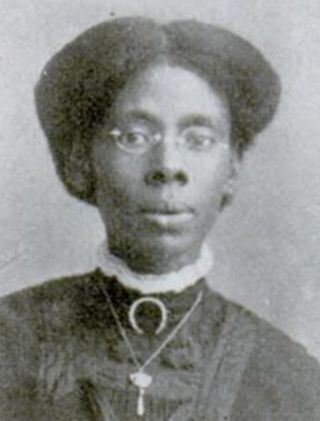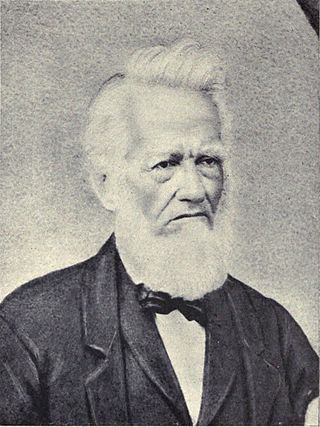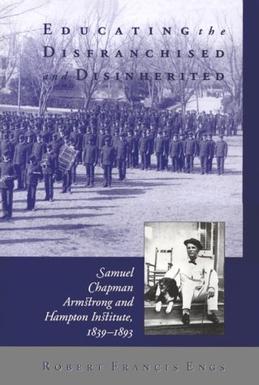
Samuel Chapman Armstrong was an American soldier and general during the American Civil War who later became an educator, particularly of non-whites. The son of missionaries in Hawaii, he rose through the Union Army during the American Civil War to become a general, leading units of African American soldiers. He became best known as an educator, founding and becoming the first principal of the normal school for African-American and later Native American pupils in Virginia which later became Hampton University. He also founded the university's museum, the Hampton University Museum, which is the oldest African-American museum in the country, and the oldest museum in Virginia.

Hampton University is a private, historically black, research university in Hampton, Virginia. Founded in 1868 as Hampton Agricultural and Industrial School, it was established by Black and White leaders of the American Missionary Association after the American Civil War to provide education to freedmen. The campus houses the Hampton University Museum, which is the oldest museum of the African diaspora in the United States and the oldest museum in the commonwealth of Virginia. First led by former Union General Samuel Chapman Armstrong, Hampton University's main campus is located on 314 acres in Hampton, Virginia, on the banks of the Hampton River.

Phoebus is an incorporated town located in present day Hampton, Virginia on the Virginia Peninsula. In 1900, it was named in honor of local businessman Harrison Phoebus (1840–1886), who is credited with convincing the Chesapeake and Ohio Railway (C&O) to extend its tracks to the town from Newport News.

Emancipation Oak is a historic tree on the campus of Hampton University in Hampton, Virginia in the United States. The large, sprawling southern live oak, believed to be over 200 years old, is 98 feet in diameter, with branches which extend upward as well as laterally. It is designated one of the 10 Great Trees of the World by the National Geographic Society and is part of the National Historic Landmark district of Hampton University.

Mary Smith Peake, born Mary Smith Kelsey, was an American teacher, humanitarian and a member of the black elite in Hampton, best known for starting a school for the children of former slaves starting in the fall of 1861 under what became known as the Emancipation Oak tree in present-day Hampton, Virginia near Fort Monroe. The first teacher hired by the American Missionary Association, she was also associated with its later founding of Hampton University in 1868.

First Baptist Church is a historic Baptist church in Richmond, Virginia, United States. Established in 1780, the church is currently located on the corner of Monument Avenue and Arthur Ashe Boulevard. The current senior minister is the Rev. Dr. Jim Somerville, former pastor of the First Baptist Church of Washington, D.C. Its historic building at 12th and East Broad streets is the home of Virginia Commonwealth University's Hunton Student Center.

Virginia Estelle Randolph was an American educator in Henrico County, Virginia. She was named the United States' first "Jeanes Supervising Industrial Teacher" by her Superintendent of Schools, Jackson Davis, and she led a program funded by the Jeanes Foundation to upgrade vocational training throughout the U.S. South as her career progressed. Her work is widely associated with vocational education. Two schools of the Henrico County Public Schools system were named in her honor and in 2009 Randolph was posthumously honored by the Library of Virginia as one of their "Virginia Women in History" for her career and contributions to education.

Orkney Springs is a CDP in western Shenandoah County, Virginia, United States. The reason for the name "Orkney" is unknown, but believed to be tied to either the Orkney Islands off the coast of Scotland or to the Earl of Orkney, since one of the earliest European landowners was Dr. John McDonald, a Scottish physician. The "Springs" part of the name comes from the numerous underground mineral springs in the area. Major Peter Higgins laid out the town in 1808, with a common area surrounded by lots; later archeological research found relics of prior Native American use of the site.

David Belden Lyman was an early American missionary to Hawaii who opened a boarding school for Hawaiians. His wife Sarah Joiner Lyman (1805–1885) taught at the boarding school and kept an important journal. They had several notable descendants.

James Phillippo was an English Baptist missionary in Jamaica who campaigned for the abolition of slavery. He served in Jamaica from 1823 to his death, with some periods lobbying in England for funds to support his work on the island. He led the founding of several Free Villages, having gained funds to grant freedmen and their families plots of land for farming in villages independent of planter control. He also wrote and published three books about Jamaica.

Richard Armstrong was a Presbyterian missionary from Pennsylvania who arrived in Hawaii in 1832. Along with his wife Clarissa, he served in mission fields of the Marquesas Islands and in the Kingdom of Hawaii. He established several churches and schools, and was Kahu (shepherd) of Kawaiahaʻo Church after the departure of Hiram Bingham I. Kamehameha III appointed him Minister of Public Instruction, and his accomplishments established an educational system that earned him the nickname "The father of American education in Hawaii".

Historic Little England is a national historic district located at Hampton, Virginia. The district encompasses 87 contributing buildings in a streetcar suburb originally laid out in 1888. The primarily residential district includes notable examples of the Queen Anne and Colonial Revival styles. Notable dwellings include the house of developer Frank Darling, Reed House, and the James Darling II residence (1927).

George Freeman Bragg was an African-American priest, journalist, social activist and historian. The twelfth African American ordained as a priest in the Episcopal Church of the United States, he worked against racial discrimination and for interracial harmony, both within and outside of his church.

Educating the Disfranchised and Disinherited is a 1999 biography of American General Samuel Chapman Armstrong and his associated normal school for freedmen, Hampton Institute, written by Robert Francis Engs and published by the University of Tennessee Press. The first full biography of its kind, the book portrays Armstrong as a complex politician and administrator in the postbellum period who balanced the needs of opposed parties surrounding the Virginia school: its African American students, Southern white neighbors, and Northern philanthropist funders. Previous works presented Armstrong in a polarized fashion, as either a savior or handicap for freedmen. The book emphasizes Armstrong's upbringing as a missionary in Hawaii in the development of his educational philosophy.
Robert Curtis Ogden was a businessman who promoted education in the Southern United States.
George Clinton Rowe (1853–1903) was an American missionary, minister, and poet. He is referred to in James T. Haley's Afro-American Encyclopaedia"" as the "Palmetto Poet".

Sag Harbor Hills, Azurest, and Ninevah Beach Subdivisions Historic District (SANS) is an African American beachfront community in Sag Harbor, New York. Founded following World War II, the SANS community served primarily as a summer retreat for middle-class African American families during the post-WWII and Jim Crow era. African American families were not allowed at beachfront resorts, pools or beaches, and SANS began as a place of refuge from racial strife. The historic district is bordered by Hempstead Street, Richards Drive, Hampton Street, Lincoln Street, Harding Terrace, Terry Drive and the eastern end of Haven's Beach in Sag Harbor. It was placed on the National Register of Historic Places on July 10, 2019.

The Williamsburg Bray School was a school for free and enslaved Black children founded in 1760 in Williamsburg, Virginia. Opened at Benjamin Franklin's suggestion in 1760, the school educated potentially hundreds of students until its closure in 1774. The house it first occupied is believed to be the "oldest extant building in the United States dedicated to the education of Black children".
Virginia School for the Deaf, Blind and Multi-Disabled at Hampton (VSDBM-H), also known as the Virginia School for the Deaf and the Blind-Hampton Campus (VSDB-Hampton) was a school for deaf and blind children in Hampton, Virginia. It was operated by the Commonwealth of Virginia.




















